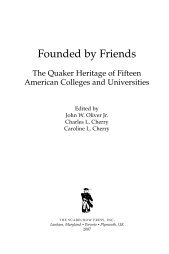Historical Dictionary of Lesbian Literature - Scarecrow Press
Historical Dictionary of Lesbian Literature - Scarecrow Press
Historical Dictionary of Lesbian Literature - Scarecrow Press
Create successful ePaper yourself
Turn your PDF publications into a flip-book with our unique Google optimized e-Paper software.
INTRODUCTION • xliii<br />
The sex variant has always been with us and probably always will be.<br />
He [sic] has been thus classified, partly because <strong>of</strong> the arbitrary designations<br />
male and female. As I have shown in All the Sexes, there are<br />
any number <strong>of</strong> possible gradations <strong>of</strong> human behavior—from that<br />
<strong>of</strong> a theoretical masculine to that <strong>of</strong> a theoretical feminine being. 8<br />
(Foster, 5)<br />
Sexology and the literature <strong>of</strong> lesbianism, which draws upon sexological<br />
inquiry, see masculinity and femininity as biological states.<br />
Whether, like Havelock Ellis, they uphold ideas <strong>of</strong> an ideal masculinity<br />
and femininity or, like George Henry, they seek to promote a new, less<br />
dualistic understanding <strong>of</strong> human sexual biology, sexological thinkers<br />
continue to see gender and sexuality as a matter <strong>of</strong> the body.<br />
Psychoanalysis, in its early development, was more dependent on<br />
sexology than is commonly acknowledged. Sigmund Freud cites sexological<br />
research in essays like “Some Psychical Consequences <strong>of</strong> the<br />
Anatomical Distinction between the Sexes,” and in one letter refers the<br />
mother <strong>of</strong> a young homosexual man to the work <strong>of</strong> Havelock Ellis.<br />
From 1910, when the first <strong>of</strong> Freud’s essays were translated into English,<br />
his work had a tremendous influence on the writing <strong>of</strong> lesbian, bisexual<br />
and transgendered women in English. James Strachey, Freud’s<br />
patient and chosen English translator was associated with the sexually<br />
dissident writers <strong>of</strong> the Bloomsbury Group. The Strachey translations<br />
were published by the press (Hogarth) founded by Virginia and Leonard<br />
Woolf. Radclyffe Hall and Una Troubridge record in their journals and<br />
letters that they read Freud aloud to each other. Djuna Barnes created<br />
long stream-<strong>of</strong>-consciousness ramblings for her homosexual characters<br />
that resemble Freud’s famous talking cure, and incorporate ideas <strong>of</strong> the<br />
Oedipal conflict.<br />
Freud built upon and complicated sexological ideas <strong>of</strong> gender variance<br />
and same-sex desire by developing the concepts <strong>of</strong> aim and object<br />
choice. Through his particular and universalizing myth <strong>of</strong> the child’s development<br />
within the family, he articulated a number <strong>of</strong> ways in which<br />
the development <strong>of</strong> the human sense <strong>of</strong> self involves desires for and<br />
identifications with both the male and female parent. In a clearly preferred<br />
scenario the child will ultimately identify with the parent <strong>of</strong> the<br />
same sex and desire the gendred other. However these are separate actions<br />
and might “go wrong” in any number <strong>of</strong> ways. Therefore one’s<br />
aim might be either masculine or feminine, that is one might desire to
















